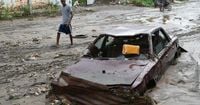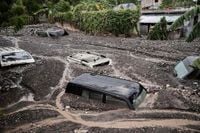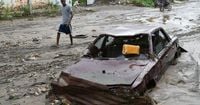Hurricane Melissa, one of the most powerful storms ever recorded in the Atlantic, has left a trail of devastation across Haiti and Jamaica, with the full extent of its impact only now coming into focus. As of November 4, 2025, Haiti’s government reported that the death toll had climbed to 43, with 13 people still missing. The country’s southwest region, battered by landslides and relentless floodwaters, remains particularly hard hit, with more than 30 communities struggling to recover.
In the coastal town of Petit-Goâve, tragedy has struck with particular force. At least 25 deaths have been confirmed there, underscoring the storm’s lethal power. According to The Associated Press, Hurricane Melissa reached Category 5 status, making it one of the strongest Atlantic hurricanes on record. Its outer bands battered Haiti last week, flooding nearly 12,000 homes and destroying nearly 200 others. The aftermath has left numerous roads inaccessible, hampering rescue and relief efforts.
With infrastructure crippled, the government has sounded the alarm about a growing shortage of drinking water in several communities. Authorities have pledged to distribute seeds and tools to farmers who are now facing the daunting prospect of major agricultural losses. For many in Haiti, the road to recovery is long and uncertain. More than 1,700 people remain in shelters, relying on aid and the hope that help will arrive before conditions deteriorate further.
Just across the Caribbean, Jamaica has been grappling with its own disaster. Since Hurricane Melissa made landfall on October 28, crews have struggled to reach over two dozen communities that remain cut off from the rest of the country. The storm has claimed at least 32 lives in Jamaica, a number that officials fear will continue to rise as more isolated areas become accessible and the true scale of destruction is revealed.
Jamaica’s Prime Minister Andrew Holness didn’t mince words when addressing the nation’s losses. “It is … a major hit to our economy,” he said on November 4, as quoted by The Associated Press. “We have never had a disaster of this magnitude.” Conservative, preliminary estimates suggest that Hurricane Melissa has caused at least $6 billion in damage to Jamaica alone, a staggering figure for a country already wrestling with economic challenges.
The United States has stepped in to support the region’s recovery. On November 4, the U.S. State Department announced it had committed $24 million in disaster relief funding for Caribbean islands ravaged by Hurricane Melissa. Of this, $12 million is earmarked for Jamaica, $8.5 million for Haiti, $3 million for Cuba, and $500,000 for the Bahamas. More aid is expected to be announced as ongoing assessments clarify the needs on the ground. According to AP Diplomatic Writer Matthew Lee, the relief for Cuba is being funneled through the Catholic Church rather than Cuban government agencies, reflecting the complexities of international aid distribution in the region.
But money alone is not enough. Mike Bassett, national director of domestic, humanitarian, and emergency affairs for World Vision International, warned of a looming humanitarian crisis if aid does not reach affected communities quickly. “I have been doing this for over 10 years, and I have never seen anything like this,” Bassett said during a visit to Jamaica. He described scenes in hurricane-ravaged communities like Chester Castle and Cambridge, where people were seen bathing in rivers and gathering water for drinking due to the lack of electricity and a functional water supply in the storm’s aftermath.
World Vision is just one of many international aid agencies and volunteer groups now working around the clock, often in coordination with Jamaican officials, to deliver relief. The country’s Transport and Energy Minister Daryl Vaz, co-chair of the special committee formed to direct relief and recovery, offered a glimmer of hope: “The relief flights are coming in fast and furious and there is no shortage of supplies.” Yet, the logistical hurdles remain immense, and reaching the most vulnerable populations is proving to be a race against time.
Pearnel Charles Jr., the head of Jamaica’s Social Security Ministry, emphasized the scale and urgency of the effort. “We are coordinating with every available resource,” he said, firmly rejecting criticism that the government’s response has been too slow. The reality on the ground, however, is that the sheer magnitude of the disaster has stretched resources thin, and many survivors are still waiting for basic necessities.
The United States has also sent disaster assistance response teams and urban search and rescue units from Virginia and California to affected countries, with a particular focus on Jamaica, where the storm’s wrath was especially severe. The State Department reported that it had responded to about 800 calls for assistance from American citizens in Jamaica, more than half originating from the popular resort area of Montego Bay. It is estimated that 11,000 Americans have left Jamaica in the wake of the hurricane, most without direct help from the U.S. government.
As relief flights continue to arrive and supplies are distributed, the challenge now is to ensure that aid reaches those who need it most, especially in remote or isolated communities. The Haitian government’s plan to distribute seeds and tools is a critical step toward restoring livelihoods, but for many, the more immediate concern is access to clean water and shelter. In both Haiti and Jamaica, the destruction of homes and infrastructure has left thousands vulnerable to disease, hunger, and further hardship.
Meanwhile, the broader Caribbean region is watching closely, aware that the lessons learned from Hurricane Melissa’s aftermath will shape future disaster preparedness and response. The international community’s swift mobilization of aid—while impressive—has also highlighted the persistent challenges of delivering help in the face of natural disasters that can overwhelm even the most robust emergency systems.
For now, the focus remains on recovery and rebuilding. Communities in Haiti and Jamaica are banding together, supported by a patchwork of local and international organizations, determined to overcome the devastation left in Melissa’s wake. The coming weeks will be crucial as officials, aid workers, and survivors navigate the long road toward stability and hope.
In the battered towns and villages of Haiti and Jamaica, the scars of Hurricane Melissa are still fresh. But amid the ruins, the determination to rebuild—and the outpouring of support from around the world—offer a measure of solace and a reason to believe that recovery, though difficult, is possible.


